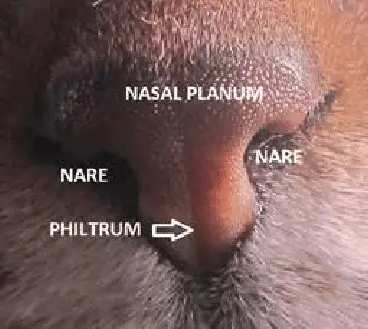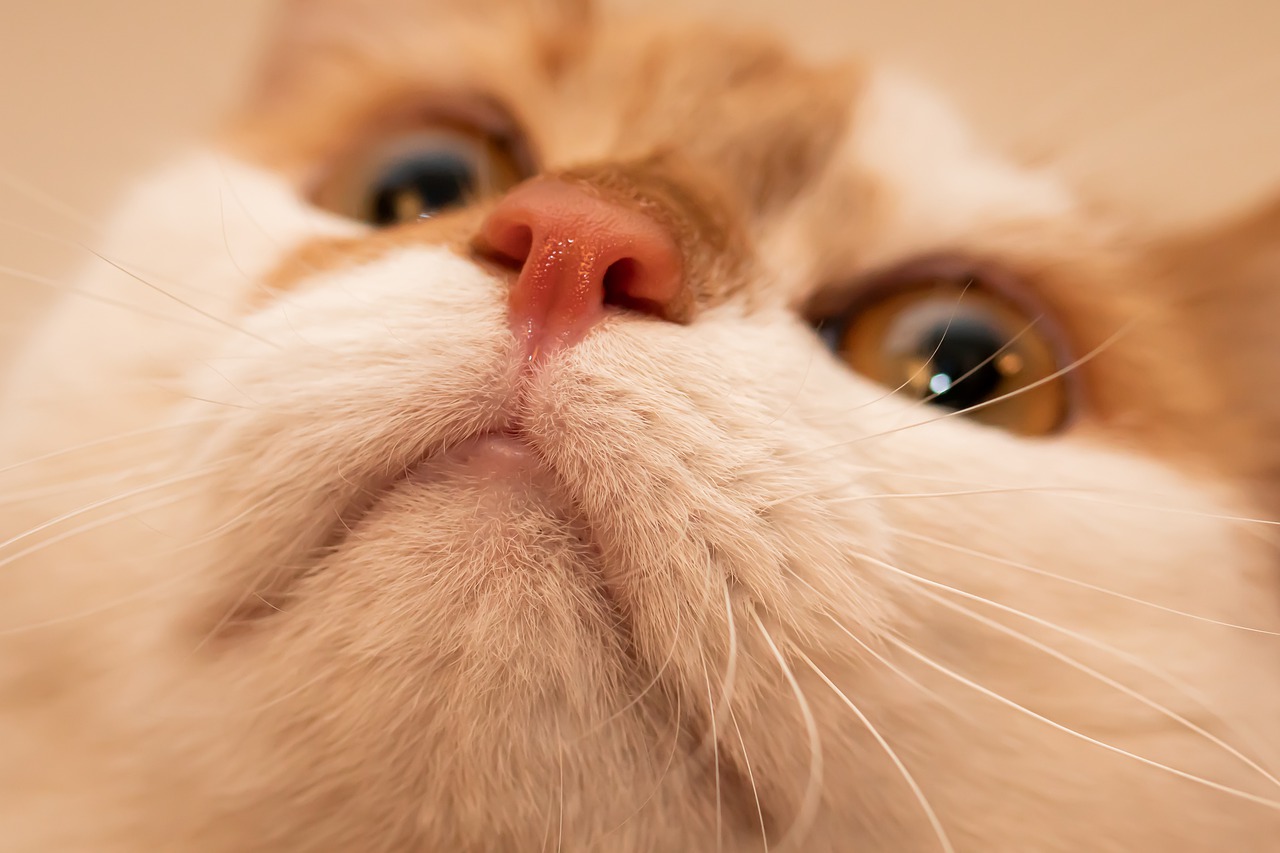WHY ARE CATS NOSES WET? THE THRUT ON WET NOSES
So, why are cats noses wet? Cats’ noses are the cutest thing, even when they are wet. But, is a wet nose a sign they are healthy or a sign that they are sick? Cats owners are often confused as to the meaning of their wet cat’s noses.
Cats’ noses are wet due to the sweat glands’ fluids on their nasal planum and the interior tear duct’s moisture. Sometimes cats lick their nose, making it soggy. Wet noses help regulate body temperature and improve their sense of smell. It indicates a healthy cat.
Let’s see when we should be worried for our kitties wet noses.

ARE CATS NOSES SUPPOSED TO BE WET?
If you like to touch your cat’s nose or to pet him often, surely you have noticed that his nose is constantly wet, besides in some rare circumstances. Does it mean that your cat is sick or that he has a cold?
Not necessarily. Cats have sweat glands near their nasal planum, which is basically the part of their nose above the nostril. The entire furless nose is called Rhinarium.

The sweat glands produce fluids that make the cat’s nose wet.
Some of the fluids that make a cat nose wet come from a duct connected to the eyes that has the purpose of draining tears or liquids. The inferior tear duct drains tear fluid from the eye’s surface, which is contributing to the moisture on top of the cat’s nose.
But, it is not all. Cats lick themselves often, adding in this way a layer of moisture on top of their nose. Another reason for a wet nose comes from a cat drinking water and thus making their nose wet by dipping it into the water.
Therefore, why are cats noses wet?
- The fluid produced from their sweat glands on their nose
- The fluid drained from the tear duct
- Moisture coming from linking themselves
- Dipping their nose into the water
WHY ARE CATS NOSES WET? AND WHAT IS ITS FUNCTION?
It is commonly believed that cats wet noses helps partially in regulating the body temperature by evaporative cooling. Sweat is normally used to lover the heat. It is not incorrect, however cats have more important uses for their “wet nose”.
One of the most important senses for cats is their sense of smell. Cats have an acute sense of smell that helps them survive and hunt. But what a wet nose has to do with it?
Cats have a Rhinarium, which is the furless skin surface surrounding the external opening of the nostril. Also called the tip of the snout.

What it does is to make cats sense of smell more acute. Cats use it to detect the direction of the wind, in fact, they can perceive where the moisture in their nose is evaporating the most. Based on this they can figure wind direction.
Not only can they figure out wind direction, but they can also capture small particles on their nose moisture and figure what smell is coming from a particular direction, even from very far. Since their nose is constantly wet, particles are sticking on it, improving their sense of smell.
Cats use the rhinarium as a sense organ, meaning they can touch any surfaces with it and detect a scent-marked object containing pheromone and figure out information, like other cats’ presence, if there is a cat in heat, etc.
ARE CATS NOSES SUPPOSED TO BE WET?
Cats’ noses are supposed to be wet most of the time because of the sweat glands, tear duct, and constant licking. It is very common to touch a cat’s nose and find it wet and cold compared to the rest of the cat’s body.
But for how long a cat’s nose can be wet depends on individual cats. Some cats may have periods through the day when their nose is dry. It doesn’t mean that it is a bad sign. Some other cats may have wet noses at all times. It doesn’t mean that it is a problem either.
For example, when my cat sleeps, his nose becomes warm and dry. It is pretty standard for him. Cats can also sleep or lay near a source of heat or in a hot place. In this case, it is difficult that a cat’s nose stays wet. Additionally, when they sleep, cats do not need to use their nose as much as when hunting.
To figure out if there is any suspicious change on your cat’s nose, you would need to know your cat enough to figure when it is typical for your cat to have a dry nose. If your cat’s nose becomes constantly dry, meaning not just for a little bit, it can be a health issue.
However, it would be accompanied by other symptoms, such as lower appetite, excessive thirst or urination, coughing, vomiting, sneezing, diarrhea, weight loss, etc.)
WHY DO CATS NOSES GET WET WHEN THEY PURR?
The phenomena of purring have not been fully understood. However, it is related to the laryngeal muscles’ movements—the blood surge through the inferior vena cava, which produces the purr’s sound.
Since it has to do with your cat’s breathing, which is typically done by the nose, it seems logical that cats purring and noses getting wet could be related. Since the sweat glands are right behind their nose, cats stimulate the glands’ activity when they purr. Purring comes from muscles work, which may get cats to begin to sweat.
Nothing is really established that connects cats purring and their nose getting wet, but if you research how cats purr and its mechanism, it is possible to see the connection.
WHY IS MY CAT’S NOSE SO WET?
In some instances, a dripping cat nose or too many liquids on the nose can be related to an upper respiratory infection. Just a wet nose is not enough to be concerned about. It is usual for a cat to have it damp.
But if there are other symptoms like coughing, sneezing, runny eyes, and even a colored nasal discharge, it is time to seek vet attention. The rest of the symptoms for an upper respiratory infection are:
- Sniffling
- Fever
- A hoarse meow
- Congestion
- Running nose
- Drooling
- Loss of appetite
- Nasal and oral ulcers
- Depression
- Lethargy
All of these are apparent symptoms far beyond the typical wet nose in cats and easy to differentiate. On the other side, a dry nose can be a sign of illness if there are other symtomps too.
RELATED QUESTIONS
Here some related questions and answers:
- Why my cat is rubbing his wet nose on me?
A cat’s nose is a sense organ. Cats use their nose, touching lightly any surface to figure out what is in it. So collected from the tip of their nose, the particles are traveling to the vomeronasal organ and its palate. Cats can understand a lot from it.
Therefore, cats can come close to you, touching base with their nose and understand things about you. It is also a sign of affection, typically when they are done touching you with their nose, they can kiss you with or rub against you.
- Is a cat’s nose supposed to be wet or dry?
Cats’ noses are typically wet, but if you have a cat who has a dry nose more often, it is not always a sign of sickness. Cats may differ even in this aspect. A dry nose can be a sign of dehydration, but it needs to be paired with other symptoms.
- How do you know if your cat is dehydrated?
It is possible to check for signs of dehydration in different places:
– Check your cat’s eyes, if they look sunken or dull, the body could be lacking moisture.
– Cat’s skin, try to pinch your cat gently on the extra skin between the shoulders blades. When you let go, the skin should get back to the normal position pretty fast. If it is not happening, your cat can be dehydrated.
– Lethargy can be a sign of dehydration.
– Hiding behavior can be a sign of dehydration.
CONCLUSION
Cats’ noses are cute and are also wet—no need to be concerned. If you know about your cat’s habit and how its nose is usually, you can spot changes and if there is the need to bring your cat to the vet. Therefore, enjoy your wet cat nose! If you have any questions or want to add anything, leave it in the comments below.







